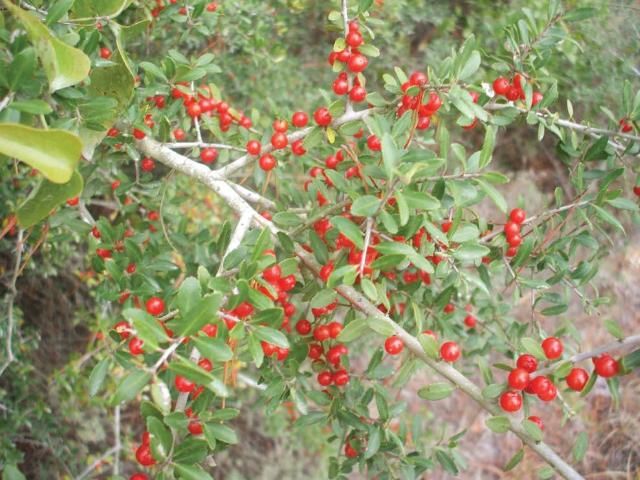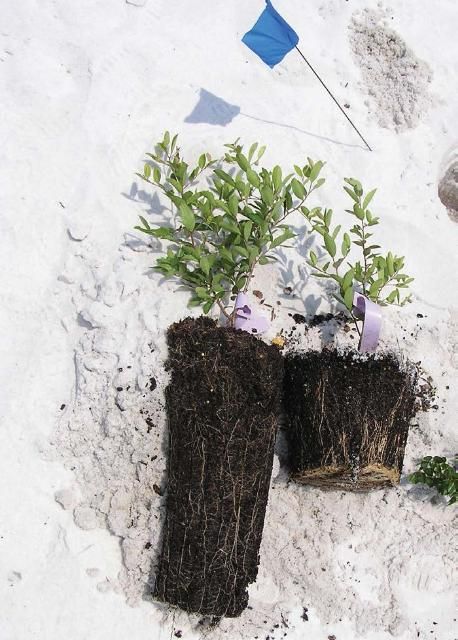Note: This fact sheet is also available as a chapter in a comprehensive manual titled Dune Restoration and Enhancement for the Florida Panhandle, available in pdf form here: https://edis.ifas.ufl.edu/pdffiles/SG/SG15600.pdf. Please see the manual for more information about other useful and attractive native plants for dunes and for further information about restoration and preservation techniques.
Aquifoliaceae

Credit: Gina Duke, UF/IFAS
Yaupon is found throughout Florida south to Lake Okeechobee and more broadly throughout the southeast west to Texas and east to North Carolina.
The leaves and small twigs of yaupon contain caffeine, and yaupon teas have been consumed by humans for centuries. The fruits and flowers of yaupon attract wildlife, especially birds and pollinators, and it is a larval host plant for Henry's elfin butterfly (Callophrys henrici) (Lotts and Naberhaus 2017). Yaupon is used in landscaping and can tolerate a wide range of environmental conditions. Several cultivars are available in the horticultural industry.
General Description
Yaupon is a dioecious evergreen shrub to small bushy tree that can reach heights of 25 ft. Leaves are alternate, simple, and dark green on the upper surface. They are elliptical to ovate, 0.2 to 2 in long by 0.2 to 0.5 in wide, and have a crenate margin, an obtuse apex, and a rounded base. Flowers are small and white and occur in leaf axils. The species is dioecious with pistillate and staminate flowers occurring on separate plants. Fruits are bright red spherical drupes that grow 5 to 7 mm wide and occur in fall and persist throughout the winter.
Propagation
The authors have had much success growing yaupon from seed of wild-collected fruits. Fruit harvested in winter months (January) are placed in water and pressed to clean flesh from seed. Cleaned seeds are sown in open flats or in 72-cell liners after moist, cool stratification (40 days at 4.5°C) to overcome seed dormancy associated with immature embryos. Germination may occur over an extended period; seedlings are grown for 2 to 4 months before they are transplanted to larger pots.
Yaupon is a common nursery crop, and vegetative propagation methods are numerous for yaupon cultivars. Generally, semihardwood (fall) cuttings can be treated with 3,000 ppm IBA (Indole-3-butyric acid) solution while hardwood (dormant winter cuttings) can be treated with 5,000 ppm IBA solution. Craig (1991) suggests using NAA (1-Naphthaleneacetic acid) on hardwood cuttings. Cuttings are rooted under intermittent mist in a well-drained substrate. Wild-collected cuttings should be collected from a broad range of plants to ensure a broad genetic diversity and a mixture of male and female plants.

Credit: Mack Thetford, UF/IFAS
Outplanting
Plants have higher outplanting survival in 14-in-deep tree pots (versus the standard 1-gal pots) and in interdunal swales (versus ridges) (Thetford et al. 2015). Outplant yaupon in the proximity of shallow swales for optimal transplant survival.
Literature Cited
Craig, R.M. 1991. "Plants for coastal dunes of the Gulf and south Atlantic coasts and Puerto Rico." USDA SCS. Agriculture Information Bulletin 460.
Lotts, K., and T. Naberhaus. 2017. Butterflies and Moths of North America. http://www.butterfliesandmoths.org/
Thetford, M, D.L. Miller, L.W. Atwood, and B.O. Ballard. 2015. "Microsite and rooting depth are more important than water-holding gel for establishment of restoration plantings of Ilex vomitoria on barrier islands in the Gulf of Mexico." Native Plants Journal 16(2):77–86.